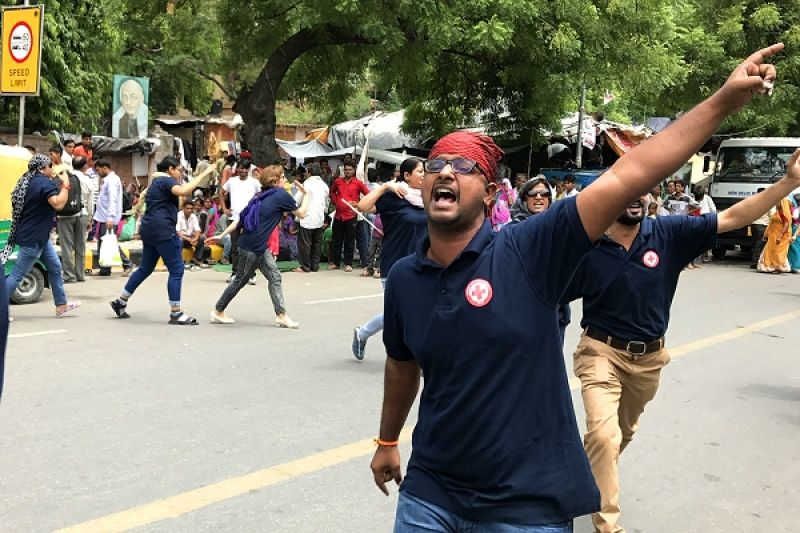Bringing the Artificial Intelligence / Machine Learning Community and Humanitarian Assistance and Disaster Response (HADR) together.

Artificial intelligence (AI) and machine learning (ML) are rapidly changing the world as we know it. Digital technology is transforming the deployment of humanitarian assistance globally. The pandemic has accelerated this transformation with no going back. For the Red Cross Red Crescent Movement, the challenge is serving the mission first, while improving the way it is being done. The priority is to achieve operational performance improvement and operations strategy to address this transformation. Yet, the adoption of advanced technology, workforce adoption, and capability building are uniquely challenging because of the scope of the humanitarian mission and the multifaceted nature of its stakeholders.
For Nan Buzard[i], Head of Innovation at the International Committee of the Red Cross (ICRC)[ii], the humanitarian assistance ecosystem is extremely specific. Humanitarian Principles and innovation must conform to bring a longer-lasting impact across the institutions and the movement. The role of the innovation team at ICRC is to bring more structure and longer-lasting impact to the adoption of these innovative technologies. Innovation is a distributed and participatory responsibility. Her role is facilitating, nurturing, and accelerating this effort with good practices and accountability through incremental improvements to enhance an independent global humanitarian action.
Difficult circumstances require taking calculated risks while adopting innovative and smarter operational technology (OT). Innovation is about experimenting with different solutions in key programmatic areas. Digitization and data, digital health, and virtual reality are the foundation of this effort, involving multiple departments, units, and delegations. It requires innovative technologies, adapted products, redesigned processes, innovative partnerships, and funding mechanisms. These synergies should merge to constantly improve and respond to changing needs and contexts, anticipating, and preparing for the future. This is a transformative shift for the Institution.
Strategic Foresight
For Ms. Buzard, the disaster relief environment has unequivocally evolved over her career at the American Red Cross and IFRC, from climate change and social unrest to youth volunteer engagement and retention. The current climate change/Covid 19 twin crisis has amplified the collaterals. The pandemic stalled detention visits and protection activities for instance. But the movement has adapted. Digitizing ICRC’s World War II archives to feed handwriting recognition software allowed more families to trace their lost members. A chat box sped up communications and efficiency for the ICRC’s forensics team effort in South Africa to help overwhelmed local authorities deal with the sudden surge of Covid-19 related deaths. The increased use of infrared cameras footage on drones to monitor and analyze agricultural fields or water systems allows forward planning.
Smarter operational technology (OT) enables humanitarian practitioners to increase disaster preparedness and response. Virtual Reality (VR) is a precious add-on to face-to-face meetings. Science and academic research show that enhanced VR training results in more retention and behavior change. In conflict environments, VR training to teach International Humanitarian Law (IHL) for the military is more effective than PowerPoint presentations. VR environments allow better knowledge retention and sharing. Digital savviness triggers behavioral change and facilitates broader means to train local actors when humanitarian assistance deployments are impossible.
For Ms. Buzard, the supply chain carbon footprint of humanitarian assistance can improve. ICRC and humanitarian practitioners are evaluating their procurement and supply chain delivery processes with an emphasis on transparency and reliability to promote environmental sustainability. With over two thousand facilities in five hundred sites across a hundred and fifteen countries, a dedicated team works on greening ICRC’s supply chain with safe, reliant, and renewable energies to secure a more efficient energy transition and transmission.
Digital Dilemmas and Algorithmic Bias Discrimination
However humanitarian practitioners have the duty to ensure their increasingly digitalized operating environments are cybersecurity safe. Using big data together with AI can threaten the right to privacy from increased surveillance and monitoring, with the risk for obvious human bias in output[iii]. “As the historic data fed to the system for training the AI algorithm inherently feature biases against some sectors of society. As a result, the compromised data gets perpetuated and embedded in the system, and the algorithm always targets a specific group of people.” The risk for the humanitarian ecosystem to bypass vulnerable population segments because of a lack of connectivity among them cannot be ignored and must be addressed.
The 2018 Toronto Declaration[iv] on the protection of the right to equality and non-discrimination in machine learning systems is an attempt in making the framework of human rights one of the foundational components of data ethic. Regulators need to develop a framework that can control any potential AI excess without stifling innovation in the field while preventing potential abuse of contact tracing tools and privacy breaches. The challenge is unlocking data, sharing, and managing in a real-time situation. However, it is important in the long term to collect data repository and protect it from malware. The solutions exist, including a data-driven focused incident management system with an integrated risk management system and ethics guidelines or books of digital adoption.
Critical Drivers to Nurture and Accelerate the AI/ML Transformation of Humanitarian Assistance
Transitioning the AI/ML community engagement to serve real-world humanitarian issues is happening. Successes in applying techniques from various AI and ML disciplines to HADR are gaining strength. The AI/ML community is embracing this shift by establishing a comprehensive dialogue with the HADR community. AI/ML applications include remote sensing, EO [electro-optical] synthetic aperture radar imagery to assess distinct parts of a disaster area that is damaged, or which is about to be flooded. The adoption of advanced technology brings multiple solutions such as forecasting disasters, targeting flooding high-water mark locations, or critical infrastructure impacts. Humanitarian practitioners can better understand or let models detect how damaged a building is after a disaster. Computer vision can do damage planning, routing across constructed roads, or build robots that can crawl around the rubble and find people, as well as stop the spread of misinformation on social media during and after a disaster.
The following initiatives demonstrate this endeavor, to make sure that fewer human lives are at risk.
AI + HADR 2021
On December 3rd, 2021, the University of California, Berkeley, the Texas A&M Center for Robot-Assisted Search and the Rescue and the Carnegie Mellon University Software Engineering Institute will conduct with hu0manitarian practitioners to help the NeurIPS research community to learn the practical challenges of the HADR community, as well as for the HADR community get to know the state of art and practice in AI.
Noble Intelligence | McKinsey Analytics | McKinsey & Company
“Noble Intelligence, McKinsey & Company, is engaging nongovernmental organizations, respected think tanks, and industry leaders as part of a global movement to responsibly use technology to benefit society and the environment. Humanitarian Assistance & Disaster Recovery. When a disaster strikes, quick and accurate situational information is critical to an effective response. Before responders can act in the affected area, they need to know the location, cause, and severity of damage. But disasters can strike anywhere, disrupting local communication and transportation infrastructure, making the process of assessing specific local damage difficult, dangerous, and slow. AI and analytics will develop and deploy innovative tools around the world to help organizations and communities achieve the United Nations’ Sustainable Development Goals.
www.mckinsey.com/business-functions/mckinsey-analytics/how-we-help-clients/noble-intelligence
xView2
“Using satellite data, xView2 developed a deep-learning image recognition and classification algorithm to assess building damage post-disaster. Using AI models on damage data, teams on the ground can optimize the distribution of temporary schools and rebuilding efforts to get more children back to school faster. AI can create machine-learning models that can find buildings and then tell me how damaged they are from electro-optical satellite imagery in the visible spectrum.
Maxar: Earth Intelligence & Space Infrastructure
Maxar monitors global change, delivers broadband communications, and advances space operations with capabilities in Space Infrastructure and Earth Intelligence, applying leading environmental, social and governance practices and solutions.
Carnegie Mellon University Software Engineering Institute (SEI)’s Emerging Technology Center.
SEI assists first responders and disaster people to better understand what parts of the world are damaged after disaster, so that
they can better plan logistics and resources,
AI and ML in all sorts of domains, human-machine interactions, machine emotional intelligence, and then advanced computing; those are the three pillars. How robots understand anomalous behavior in their environments to interact with different humans in their surroundings through inverse reinforcement learning to understand autonomous robotic behavior.
Search-and-rescue robot.
Researchers deployed a snake-like robot to search for trapped survivors in a Mexico City apartment building that collapsed in the7.1-magnitude earthquake that shook the city Sept. 19. The multi-jointed snakebot provided rescue workers with a video feed from two different passes through the rubble but did not find any survivors. Systems scientist in CMU’s Robotics Institute are exploring the use of robots to get in these tight places that humans would never have a chance of getting into and exploring and serving as a force multiplier to find people when there are not enough people on the ground.
Other research includes the use of autonomous drones to locate stranded, isolated communities and drop those resources or communicate with them. Or the use of natural language processing and social media to find disinformation and help disaster agencies or coordinating agencies put a stop to it before it gets to panic state.
Argonne National Laboratory
Understanding how big debris piles are is a challenge. Drones, through volumetric LIDAR scans of debris piles can give an accurate measurement of cubic tons of debris in an area, and how much effort it would take to move it. Drones can assess the volume and nature of debris without people taking risks to go to the sites of disasters.
Conclusion
The AI ML community partnership with the HADR community is fostering an ecosystem to accelerate collective learning and impact measurement, unlocking an abundance of positive outcomes. For ICRC, these thematic clusters keep unfolding from mapping modern and future wars or predicting new weapons of destruction, to measuring the impact of climate change on conflicts as more people keep fighting over diminished resources. Seventy percent of ICRC’s Innovation think-tank’s initiatives are picked-up and put into strategies and into practices throughout the organization. It is an achievement. The AI ML HADR partnership helps disaster preparedness, reducing negative impacts and saving lives.
[i] Discussion with Naan Buzard’s Journey in the Red Cross Movement, ICRC, 09.16.2021
[ii] www.icrc.org/en/publication/4564-innovation-cicr-0
[iii] Human Rights, Big Data and Technology Project. RightsCon 2018. Mobilising the Might of Rights: A Human Rights Based Approach to AI. www.hrbdt.ac.uk



